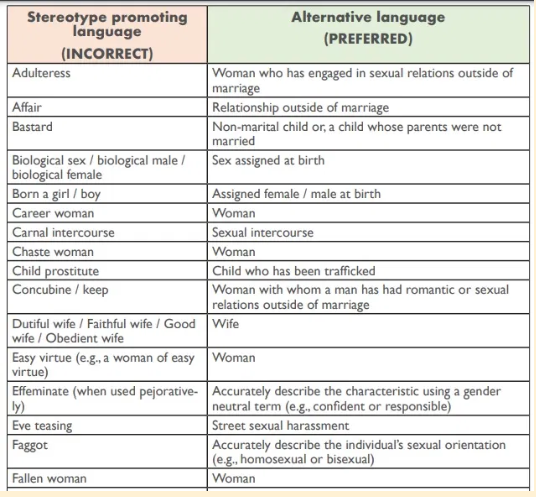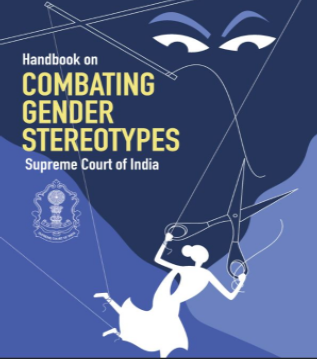Introduction
Gender stereotypes have long been entrenched in society, exerting a profound influence on how we perceive, anticipate, and engage with each other, ultimately fostering inequality and curtailing individual agency. These stereotypes assign specific roles, attributes, and behaviors to individuals based on their gender, often perpetuating inequality, discrimination, and limiting personal freedom.
The Supreme Court of India has released a “Handbook on Combating Gender Stereotypes”. The main motive behind the handbook is to combat gender stereotyping in the legal discourse and the way courts work in the country. It strives to achieve a discrimination-free judicial system treating men and women equally and challenging patriarchy.
Manifestations and Consequences of Gender Stereotyping
There are several manifestations and consequences of gender stereotyping. Media portrayals and cultural influence play a significant role in shaping societal perceptions. Movies, TV shows, advertisements, and other forms of media often perpetuate gender stereotypes by depicting men as strong, independent, and rational, while portraying women as emotional, submissive, and primarily concerned with their appearance.
Similarly, the Educational system and early socialization is also an important point in this regard. Textbooks, classroom dynamics, and extracurricular activities can inadvertently reinforce gender stereotyping by assigning certain subjects as more suitable for one gender over the other which further leads to discrimination.
Gender stereotypes extend into the professional world, influencing hiring decisions, promotions, and overall workplace dynamics. This instead of trying to break barriers and dismantle patriarchy, ends up making it stronger.
If we look at the consequences of gender stereotyping, they are devastating, to say the least. The perpetuation of discrimination against women through gender stereotyping restricts personal freedom and increases inequality. Some critical consequences include limiting opportunities, mental health impact, and reinforcing inequality. Women aren’t able to pursue their desired careers if they “don’t fit in” or are “too loud” or the “feminist” type. They have to compromise in every field, be it household, jobs, leadership roles, etc.
The Supreme Court Handbook
The motive behind the Handbook on Combating Gender Stereotypes released by the Supreme Court of India is to promote the usage of unbiased, discrimination, and stereotype-free language in legal discourse and be respectful to all individuals, irrespective of their gender.
The handbook lists several terms and words that are inherently very problematic but have been so internalized and normalized for women in a society that, to change this behavior, people will have to go the extra mile. And this is exactly why, this handbook stands as a milestone in addressing not only the very visible women’s issues like political representation but the internalized misogyny in the minds of people
To challenge this misogyny is to move a step closer to dismantling patriarchy. These unnoticed forms of gender stereotyping harm more than visible gendered violence because the subtle forms of discrimination legitimize the narrative that women are inferior and deserve to be cat-called.

Provided above is a part of the elaborate list that the Supreme Court has outlined. This shows how women are held characterless, irrational, or over-emotional because the “masculine” qualities of rationality and strength have been assigned the superior plane. Have you ever heard the words “working man” or “career man”? Certainly not! It comes as a surprise to people that women can work too hence the added adjective of “career woman”.
Why is this Handbook Significant?
Considering everything that has been discussed till now with the context in which this discourse is placed, this handbook plays a vital role in reducing gender stereotyping. It draws attention to typical stereotypical words and expressions that are frequently used in court papers to characterize women. It highlights instances where gender roles are perpetuated and provides a way out by listing the correct terminology to be used.
This is exceptionally significant because the judicial system is the actor responsible for upholding right conduct in the country and the Supreme Court being the apex judicial institution is responsible for upholding constitutional values of equality and fairness.
The actions of courts have the power to legitimize narratives and views in society. Hence, when the Supreme Court stands strong against gender stereotyping, it leaves a message that this is something that is not only legally unacceptable but also immoral and so, socially unacceptable. Legal change is the first step for social change.
Conclusion
Gender stereotyping affects women in their everyday lives. Women are shamed for the same things that men are applauded for. Patriarchy has always been so entrenched in society that using terms like “chaste woman” has become too common. Women who take their careers seriously and don’t conform to gender roles are labelled “characterless.
Thus, the Handbook on Combating Gender Stereotypes by the Supreme Court of India is an important step in this direction. It kickstarts the very much required legal discourse around misogyny, microaggressions, and discrimination against women.
We can only hope that this step taken by the Supreme Court materializes in the right direction, the legal language becomes respectful to all genders and finally, some sort of change can be seen in the internalized misogyny in society.
-ADITYA SRIVASTAVA
MUST READ: DEMOCRACY IN 2023: THRIVING OR DYING?





